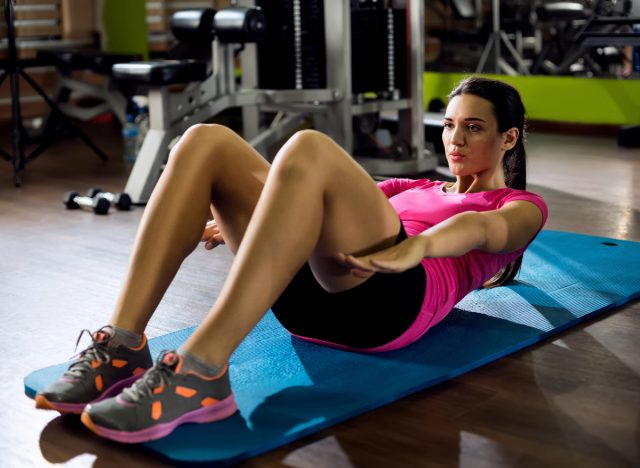If You Can Do This Many Sit-Ups After 55, Your Core Beats Most People Your Age

Sit-ups may seem old-school, but they remain one of the most straightforward and revealing measures of real-world core strength. In just a single minute, you can test your endurance, mobility, and stability without needing a gym or equipment. The number of sit-ups you can complete in 60 seconds says a lot about how well your core supports your spine, posture, and overall athletic performance.
A strong core goes far beyond aesthetics. It keeps your back healthy, helps you move efficiently, and protects your balance as you age. Every time you sit up, you’re using more than just your abs. Your hip flexors, lower back, and stabilizers all play a role in this movement. This test makes it a reliable way to assess how well your midsection functions as a unified system.
For adults over 55, the sit-up test is a simple yet effective benchmark. It’s a quick way to see how your training habits are paying off and where you can still improve. The stronger your core, the better your ability to perform daily tasks, maintain proper posture, and reduce your risk of injury.
If your number lands in the top range for your age group, you can proudly say your core is stronger than most. Let’s break down what those numbers look like and how to keep improving your results.
Why the Sit-Up Test Matters After 55

Your core strength influences almost every movement you make. Whether you’re getting out of bed, standing from a chair, or bracing while lifting groceries, your abs and surrounding muscles provide the foundation for safe, controlled motion.
As you move past 55, maintaining that strength becomes more critical for spine stability and injury prevention. Weak core muscles can contribute to back pain, limited mobility, and a slower metabolism. The sit-up test reveals more than endurance; it also highlights how well your body recruits and coordinates the muscles that keep you upright and steady.
Improving your sit-up capacity can also boost your posture and help combat the forward-leaning tendency that develops with age. A strong midsection supports the spine and prevents slouching, allowing you to move confidently throughout your day.
How Many Sit-Ups Show Your Core Is in Top Shape

To test yourself, lie flat on your back with knees bent, feet flat, and hands across your chest. Have a timer ready for 60 seconds. Count one rep each time your shoulders rise until your elbows touch your thighs, then return to the starting position.
Here’s a general breakdown of how your score stacks up:
- Under 20 Sit-Ups: You’ve got a starting point to build from. Focus on basic core activation drills and steady progress over time.
- 20–30 Sit-Ups: You’re in fair shape. Your endurance is developing, but you can still build more stability and control.
- 31–45 Sit-Ups: You’re in solid shape. Your core strength is above average for your age, showing great muscular endurance and coordination.
- 46–55 Sit-Ups: You’re in excellent shape. Your abs and hip flexors have impressive control and stamina.
- Over 55 Sit-Ups: You’re in elite shape. This level of performance demonstrates exceptional core endurance and strength for someone of over 55 years old.
Re-test every month to see how your strength and endurance improve. Even a slight increase in your sit-up count shows significant gains in muscular conditioning.
The Smartest Ways to Build Sit-Up Strength

Improving your sit-up count requires a mix of strength, stability, and proper technique. Strengthening your entire core, not just your abs, will help you perform more reps safely and effectively.
- Strengthen your foundation: Add planks, dead bugs, and hollow holds to your weekly training. These moves strengthen deep core muscles that stabilize your spine during sit-ups.
- Train your hip flexors: Perform seated marches or hanging knee raises. Strong hip flexors make each sit-up more efficient and reduce fatigue.
- Practice partial ranges: Start with crunches or half sit-ups if you struggle with full reps. Gradually increase your range of motion as your strength improves.
- Focus on controlled movement: Avoid rushing. Aim for smooth, consistent reps that maintain tension throughout your abs. Quality form prevents back strain and helps you last longer during testing.
- Mix in endurance training: Incorporate light cardio like brisk walking or cycling. A strong aerobic system helps you maintain pace and recovery between reps.
RELATED: 5 Standing Exercises That Firm Thighs Faster Than Leg Machines After 50
Daily Habits That Support Core Strength

Improving your sit-up score isn’t just about training harder. Small lifestyle habits play a big role in how strong and stable your core feels every day.
- Stay active daily: Walk, stretch, and move regularly to keep your midsection engaged throughout the day.
- Eat for recovery: Include protein-rich meals to rebuild muscle after workouts.
- Hydrate often: Proper hydration supports energy and muscle contraction during training.
- Improve posture: Keep your chest tall and shoulders back while sitting or standing to maintain natural core engagement.
- Sleep well: Recovery is when your muscles grow stronger and your energy replenishes.
The stronger your core, the stronger your entire body becomes. With regular testing and consistent exercise, you can maintain impressive endurance, stability, and strength well into your 50s and beyond.